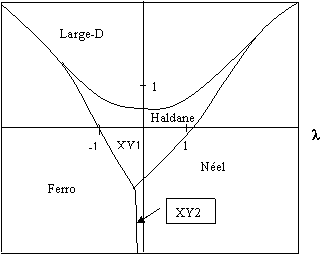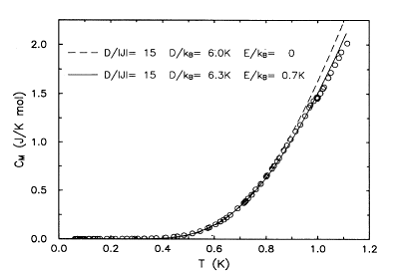QUANTUM SPIN CHAINS
A. Orendáčová, M. Orendáč, A. Feher, E. Čižmár, J. Černák
The theorists knew for decades that the classical Néel ground state is not the true ground state of the Heisenberg antiferromagnetic chain with integer spin S. In his pioneering work [1] Haldane quantitatively estimated ground-state properties and excitation spectrum of the “mysterious” object. He showed that the ground state is disordered with S = 0, separated from the excited S = 1 magnon state by the Haldane gap Eg ? JS2exp(-?S). As can be seen, the size of the gap strongly depends on the spin value due to the effect of quantum fluctuations which destroy the Néel order. Since the real materials are characterized by the presence of interchain coupling, J´, exchange and crystal field anisotropy and other effects, many theoretical studies tested the persistence of Haldane gap with respect to the aforementioned effects. General form of the Hamiltonian describing real quasi-one-dimensional compounds is:
![]()
![]()
where ?, D and E represent exchange, single-ion and in-plane anisotropy, respectively. The effects of exchange and single-ion anisotropy are very different and the system exhibits a rich phase diagram shown in Fig.1.

Fig.1
Experimental studies of chain-like material Ni(en)2Ni(CN)4, (NENC) revealed a dominant influence of single-ion anisotropy D [2]. The local surroundings of Ni(II) ion generates easy-plane anisotropy, consequently, NENC can be identified as a first well defined realization of a quantum chain from “large-D” phase. Corresponding model of diluted excitons enabled a sufficient explanation of a steep exponential decrease of the specific heat observed below 0.8 K, indicating a presence of the gap in the excitation spectrum introduced by a relatively strong single-ion anisotropy D ? 5J, J/kB ? -1 K (Fig.2). Our work stimulated further theoretical interest in the high-temperature thermodynamics of the “large-D” phase [3]. The studies found that the onset of mutual excitonic interactions appears at a temperature ? 0.15 D/kB, which coincides with our experimental observations. Experimental studies of Ni(bpy)2Ni(CN)4• H2O (bpy = C10H8N2) identified the compound as a quantum chain with a large rhombic anisotropy E ? 0.5D and D ? 5 J. Such a strong rhombicity [4] prevents a correct description of the thermodynamics within a strong coupling theory [3] valid for E < 0.15 D. The appearance of the Heisenberg chain material with a large rhombic anisotropy triggered theoretical calculations of thermodynamic properties of Heisenberg chains with arbitrary D, J, E parameters at finite temperatures [5].

Fig.2
In an attempt to obtain a material from the boundary between the “large-D” phase and Haldane or XY1 phase, other cyanocomplexes have been synthesized, namely Ni(tn)2Ag2(CN)4 (tn = 1,3-diaminopropane) and Ni(en)2Pd(CN)4 which were obtained by substitution of bridging atoms and/or ligands from a local Ni(II) octahedron [6, 7]. However, the observed magnetic properties led us to the conclusion that the physics of the Ni(II) cyanocomplexes is always governed by the major influence of crystal field, consequently, they represent very useful systems for comfortable study of physics of “large-D” phase, “ferro” and Néel phases especially in saturated magnetic fields. On the other hand, Ni(II) xanthates with shorter exchange bridges between Ni(II) ions along the chains should be better candidates for the localization at the boundary. Experimental studies of magnetization and susceptibility of [Ni(Prixa)2(pyr)]n yielded promising results suggesting that the system might be characterized by D, J parameters from the vicinity of the border between the Haldane and “large-D”/Néel phase, |D| ?| J|, J/kB ? -3 K [8]. However, specific heat measurements revealed a phase transition to the ordered state at 2.2 K [9]. A strong overlap of the anomaly and a round maximum resulting from short-range correlations prevents a detailed analysis of the low-dimensional effects in [Ni(Prixa)2(pyr)]n. A proper ligand substitution would be desirable to suppress the formation of interchain hydrogen bonds responsible for the deviations from the magnetic one-dimensional structure.
[1] F.D.M. Haldane, Phys. Rev. Lett. 50 (1983) 1153.
[2] M.Orendáč, A.Orendáčová , J.Černák, A. Feher, P.J.C.Signore, M.W.Meisel, S.Merah, M. Verdaguer, Phys.Rev. B 52 (1995) 3435.
[3] N.Papanicolaou, P.N. Spathis, Phys. Rev. B 52 (1995) 16001, G. Kamieniarz, R. Matysiak, A.C. Dauria, V. Esposito, Phys. Rev. B 56 (1997) 645, G. Kamieniarz, R. Matysiak, Comp. Mater. Sci. 28 (2003) 353.
[4] M. Orendáč, E. Čižmár, A. Orendáčová, J. Černák, A. Feher, M.W. Meisel, K.A. Abboud, S. Zvyagin, M. Sieling, T. Rieth, B. Luthi, Phys. Rev. B 61 (2000) 3223.
[5] Batchelor MT, Guan XW, Oelkers N, J. Stat. Mech.-Theory and Experiment (2004) P10017. I. Juhász Junger, D. Ihle, J. Richter, Phys. Rev. B 72, (2005) 064454.
[6] J. Černák, K. Abboud, J. Chomič, M.W. Meisel, M. Orendáč, A. Orendáčová, A. Feher, Inorganica Chimica Acta 311 (2001) 126.
[7] J. Černák, J. Lipkowski, E. Čižmár, A. Orendáčová, M. Orendáč, A. Feher, M.W. Meisel, Solid State Sciences 5 (2003) 579.
[8] A. Orendáčová, M. Orendáč, Y. Trávníček and M.W. Meisel, phys. stat. sol. (a) 196 (2003) 278.
[9] A. Orendáčová, A. Zorkovská, J.-H Park, M. Orendáč, Z. Trávníček, A. Feher, M.W. Meisel, phys. stat. sol. (c) 3 (2006) 134.